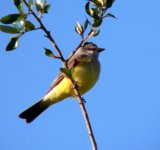The kingbird is a gray, white and yellow bird with no wing bars. A mockingbird is also gray but has no yellow on it whatsoever and has two white wingbars.
In the warm light of early morning or late afternoon, its underparts could show warmer tones especially on the underbelly, as yours does here. But never the lemon yellow of a kingbird. The photo's color register is also off, showing the wire and the bird as being brown rather than in the gray tones that would normally be the case.
When I lightened the first two shots in Photoshop, not only were the wingbars more obvious, but I could also see the characteristic thin, darkish eyeline that runs through the mocker's eye from bill to just behind the eye.
However, both birds have white outer tail feathers and both birds are a medium gray on top, so I can certainly understand how they could be hard to differentiate unless you get good looks at them in good light. :t:
Or if they are singing. Mockingbirds are just wonderful to listen to and have a hugely variable repertoire of songs whose phrases they repeat 3-5 times and can sing for several minutes without stopping. A kingbird sounds nothing remotely close to what I'd call "singing" -- more like rhythmic call notes.
Edited to dissemble

:
Y'know, I think I'm changing my mind about that 3rd photo. I have to agree with Kolya about how incredibly long that tail is. I'm also thinking the bill looks too long for a kingbird, and I can even imagine seeing an eyeline more clearly here. But I'm still very much bothered by no wing bars and by the yellow belly (even with all the red/brown taken out of the photo, that belly is still yellow, which is not a mocker characteristic).
But I also know not to trust the way colors are represented on the 'net and on individual monitors, so assuming the belly isn't really yellow, that still leaves the wingbar question. Maybe the bird is in molt and they aren't showing as prominently as they otherwise would? :h?:





